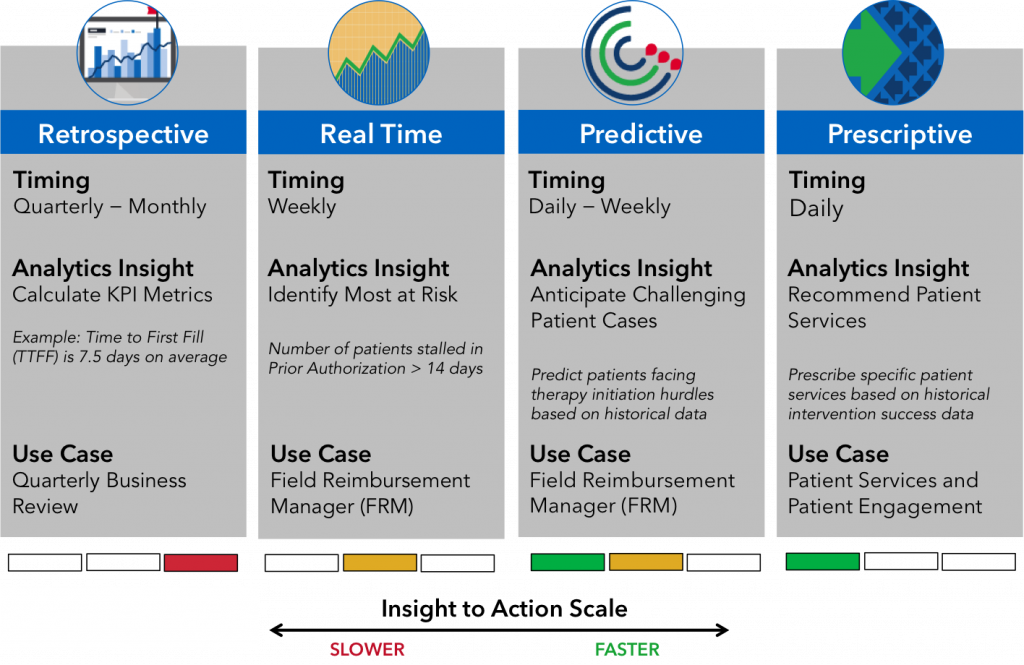A specialty brand’s goals for diagnostic patient journey analytics and actionable insights are highly dependent on decisions made when drawing up specialty pharmacy provider (SPP) data contracts. Here are five practical recommendations that will help specialty brands enable meaningful patient journey diagnostics and ultimately advance the end goal of saving patient days of therapy.
STEP 1. Request More Frequent Patient Status Updates, More Frequent Transmission of Data
How often an SPP records patient status updates and how often that patient status data is transmitted greatly impacts the level of insight a specialty brand can gain into the patient journey. When it comes to patient status updates ⎯ and more specifically sub-status updates ⎯ more data is universally better. Diagnosing the root cause of friction points in the patient journey and providing patients the resources necessary to overcome those obstacles are much more attainable goals when a specialty brand contracts for daily or even intra-day status updates.
Sign Up for a Specialty Patient Journey Analytics Workshop
Figure 1 below shows how the shift from weekly to daily to intra-day updates provides a greater level of patient journey detail for specialty brands.

Figure 1: The increased number of patient journey updates, represented here by each block, is apparent when moving from weekly to daily to intra-day patient status updates.
In terms of time-to-action for job roles such as Field Reimbursement Manager (FRM), daily and intra-day updates provide the foundation for the real-time insights needed to support challenging patient cases when they are most risk.
STEP 2. Require Specialty Pharmacies to Enter Status Updates in the Context of the Patient Journey
Each row of patient status data entered by an SPP should not be treated independently. Individual rows of data belong to a sequential patient journey where the order in which the patient progresses through journey stages and the time spent in each stage are critical data points.
There are certain sequences being reported by SPPs, that in the context of the overall patient journey, do not make sense and are therefore invalid. Adding to the problem, specialty data aggregators are not doing enough in a data stewardship sense to correct for these inconsistencies.
Figure 2 below shows two examples of invalid patient journey sequencing. By definition, a Cancelled patient status indicates that the patient has not filled an initial script to start therapy. A Cancelled status could not, by definition, follow an Active Shipment in the patient journey.

Figure 2: A visual representation of invalid patient journey sequences is a helpful resource specialty brands can provide to SPPs as an appendix to data contracts.
In the second example, we see a Discontinued patient status appears before an Active Shipment for a new referral. A Discontinued status should only follow an Active Shipment. Most likely, a patient would initiate on therapy, receive a number of refills and then discontinue due to side effects, financial reasons, drug holiday, etc.
A visualization of these invalid sequences entered into an appendix of the SPP data contract would help educate the technicians entering records.
STEP 3. Request Separate Dispense and Patient Status Files
A specialty brand expects the patient status data it receives courtesy of an data aggregator created by a SPP to be accurate and complete. That is not always the case: patient status data is often missing, incomplete, and not actionable. Therefore, specialty brands should take an extra step to establish a source of truth for the information and records they receive when possible.
Requesting separate patient status and dispense files (as opposed to a single file containing both) from an SPP is a reliable accuracy safeguard that specialty brands can put in place to verify the information they receive relative to an active shipment/patient receiving therapy is correct. Asking for separate files is beneficial in other ways including easier patient status restatement without impacting the dispense file and improved data warehouse integration.
STEP 4. Define Specialty Analytics Goals, Let Those Goals Drive Data Contracting Decisions
Decisions made in the specialty data contracting process dictate the level of data analysis a specialty brand can perform. How quickly a specialty brand can impact the patient journey is also largely determined by data contracting decisions. Contracting for limited sub-status granularity and less frequent transmission of data coupled with missing patient and payer details won’t allow for real time or predictive analytics.
As you can see in Figure 3 below, data analytics evolve along a continuum from Retrospective to Prescriptive. If a specialty brand intends to push the envelope and graduate to the more complex analytics moving to the right along the Insight to Action scale, data contracting decisions must match those goals.

Figure 3: The Evolution of Specialty Analytics. The detail and timing of a specialty brand’s analysis outlined here is largely dependent on SP data contracting decisions.
A specialty brand has to ask these questions early in the process: does successful initiation of therapy require supporting challenging patient cases in real time or is monthly retrospective reporting in an Account Management Review sufficient?
STEP 5. Create Financial Accountability Metrics to Formalize Expectations around Data Quality
Establishing a track record of providing high quality patient status data is one way for an SPP to differentiate its services against competitors. However, at this point in time, potential competitive advantage does not appear to be a strong enough incentive on its own to compel SPPs or specialty data aggregators to consistently deliver on quality.
Brands need to create contractual language that sets parameters for data quality and ties an SPP’s financial incentives to the most impactful patient journey data quality metrics.
IntegriChain recently introduced a Patient Journey Completeness Metric as part of its Specialty Analytics product to give specialty brands a data quality measurement truly aligned with their ability to gain actionable insights into the patient journey.
To create accountability around such a metric, a specialty brand must include data contract language similar to the following:
Specialty Pharmacy A is required to record an update when a status changes. Specialty Pharmacy A also agrees to to provide a patient status update every 5 business days prior to the patient’s first fill. Updates are required even when a status does not change.
IntegriChain’s Patient Status Update Completeness Metric for financial accountability reports how well the SPP is doing with patient journey updates. The metric reports the SP is x% compliant with data update frequency stipulated in the contract language.
For more information on Specialty Pharmacy Data Contracting, watch the IntegriChain webinar Specialty Pharmacy Data Strategy: Contracting for the Right Data.






